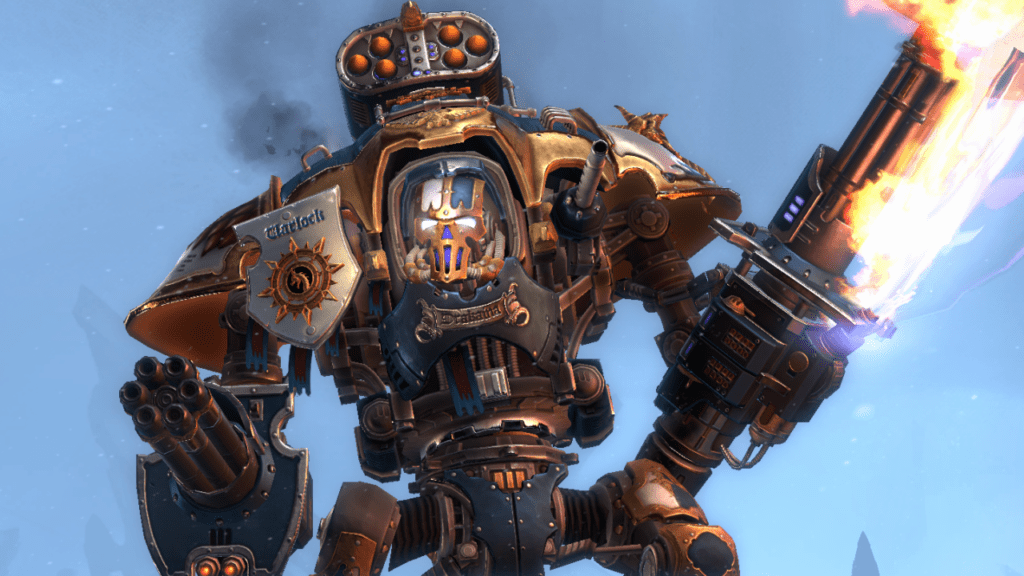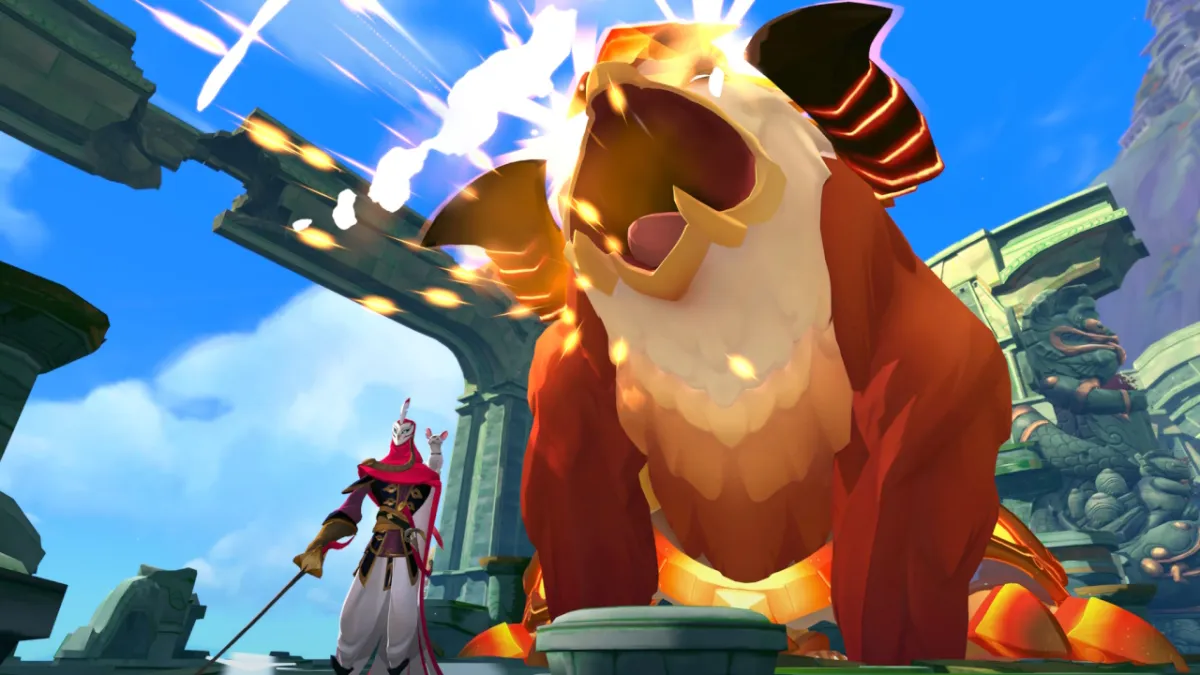Round up the Ork boyz, pledge allegiance to the scarily theocratic God-Emperor, and polish the Eldar webways, because the factions of the 41st Millennium are going to war. Not that they ever really stop. Dawn of War 3 is Relic’s third real-time strategy outing in Games Workshop’s colours, and they’ve switched things up once again. Where Dawn of War was a somewhat traditional base-building RTS, and Dawn of War 2 was all about control over small squads and talented commanders, the third game attempts to marry a little from both; while also keeping its eye on the looming influence of MOBAs on the contemporary multiplayer landscape.
The aim is presumably to satisfy proponents of both prior titles and excite (or keep hold of) those who’ve gravitated towards Hero-centric multiplayer over the past few years. There’s perhaps even a glimmer of hope that Dawn of War 3 could nudge its way into the increasingly crowded realm of competitive esports. But the risk here is that the hybrid approach pleases no-one, and the esports gambit proves as futile for Relic as it has so many others chasing that particular dragon.
The structure of play in both the majority of single player campaign missions and the title’s one and only multiplayer mode share significant similarities. Whether you’re playing as Orks, Eldar, or the Space Marines (the three factions present at launch), base and troop construction relies on the acquisition of resource points that will then provide you with Requisition and Power. Like Relic’s Company of Heroes 2, there are a fairly limited number of base structures; generally speaking, a couple of infantry barracks (basic and specialised), a vehicle building, and an armory for upgrades. Some, like the vehicle building, tend to be locked off until you’ve upgraded your main command center (or, in the case of the Orks, built more Waaagh! towers).
Capturing more resource points means more Requisition and Power to pump into your base, troop production, and the resource points themselves (creating a cycle of even more resource generation). Single player missions also have cannisters of resources laying around at certain points.
Cover still exists to an extent in Dawn of War 3, but is very different to the mechanic found in DoW2 (or, indeed, CoH2) where almost every wall-like object was a potential blockade. In this game, cover takes two forms; shielded ‘domes’ (usually near resource points) that can be captured and held for major protection against projectiles, and ‘stealth’ areas. Units placed in the latter cannot be seen unless an enemy unit also enters the stealth area, or are revealed by a scouting unit or troop ability of some kind. The lack of much cover, combined with the increased speed with which units can melt away in seconds under fire, turns almost any battle between forces into a set of bloodied corpses much faster than in previous titles. Combat in this game can be resolved very quickly.
There’s no longer a dedicated ‘Retreat’ button, but knowing when to back out of encounters and reinforce squads back at base is still important.
All of that, the base building, resource capture, control over multiple troop units (which each have preferred foes and clear ‘counters’), is pretty firmly in the RTS category. Things arguably get a little more MOBA-influenced with the inclusion and function of Elites, and a couple of mechanics specific to Dawn of War 3’s multiplayer.
Elites are the heavy-hitters of Dawn of War 3, much tougher than regular units and with unique cooldown abilities. Some are named characters (many from prior Dawn of War games) like Blood Raven leader Gabriel Angelos, or Ork Warboss Gorgutz. Others are the more specialised units from the tabletop game, like Assault Terminators or an Eldar Wraith Knight. You take three of these Elites into a match (single player levels sometimes mix this up a bit, but in multiplayer it’s always three), and each one has a ‘summoning’ cost based on their overall strength and qualities. Alongside your Elites, you also select three army doctrines; more on those and the system of unlocking a bit later.
In order to call in one of your Elites, you need a special Elite resource (which doesn’t really have a name beyond that, it’s represented by a purple diamond). This ticks slowly upwards of its own accord but can also be gathered more quickly from Elite resource points. These only appear only in multiplayer and are likely to be hotly contested.
The existence of these Elite units isn’t exactly a big flashing MOBA sign in and of itself (various RTS titles have had special, powerful units since forever), especially as these units do not really level up during the progression of a match. However, the incorporation of more Hero-like figures does have an influence on the design and layout of the handful of multiplayer maps.
As mentioned, there aren’t a huge number of multiplayer maps. Eight in all (three each of 3v3 and 1v1; two 2v2). Due to the nature of the multiplayer mode, they’re all pretty symmetrical.
To win a multiplayer match in Dawn of War 3, it’s necessary to take out an opponent’s dangerous base turret(s) (protected by a shield generator which must be destroyed first), and then destroy their main Power Core structure. Shield generators and turrets appear on the maps in default positions and will often funnel attacks down specific ‘lanes’. You’re likely to see players pushing hard on one flank or the other in order to get at one of the turrets and fashion a route to the Core.
Along with that, matches go through four phases of Escalation. In phase one, you get partial (25%) refunds for destroyed units. Later phases dramatically ramp up the amount of resources coming in from each point (up to 150% at peak) and boost their defenses, upping the stakes for holding and capturing.
This mechanic, in combination with the (partial) lack of cover, the need to destroy default base structures in order to triumph, and the increased fragility of most basic units in combat, all seems designed to push players on the offensive. Turtling and fortifying resource points will only get you so far. Losing units in Escalation phase one is less of a disaster than usual, and making an early claim on resource points will pay off in later phases. But it also means full on rush tactics won’t immediately succeed, due to the barrier of the victory conditions. This aspect appears designed to make exciting comebacks more viable, as the defensive base buildings and the Escalation mechanic delay any definitive tipping points.
A little bit of meta-strategy is added by the differing strengths and unit costs of your Elites. Opt for a ‘cheaper’ set and you’ll be able to harass key areas early. A more balanced, or cost-heavy, trio will be more dangerous, but won’t be appearing until later parts of the match (a part you may not even reach if things go poorly).
My experience with live Dawn of War 3 multiplayer matches was restricted to the closed beta weekend, which featured plenty of players (including myself) still feeling their way around the new systems and mechanics. The review build enabled skirmish matches with the AI too, but that’s obviously less instructive than matches against real players. With that in mind, there’s no way of judging longer-term aspects like the intricacies of whether one Elite ability or another is too overpowered and in need of balance. It’s also difficult to be sure if restricting multiplayer to the one game mode will be a problem for longevity, but I suspect Relic will ultimately need to introduce new ones to revitalise matters.
Those who played Company of Heroes 2 will probably want some reassurance over the system of unlocking army doctrines. In short, most aspects can be unlocked at a more rapid pace than CoH2. A caveat here that the review build values may differ from the final release version; but the patch information I’ve seen on that suggests the ‘Skull’ resource earnings for unlocks will actually be boosted. It takes 200-300 Skulls to permanently unlock an Elite unit, and you receive 80-100 from playing a single player campaign mission on Normal difficulty. By the end of the campaign that should leave you with 1,500 or so, plus the small stockpile you begin the game with (this, too, is said to be increased for the final release).
Basically, a campaign play-through should leave you with at least enough to unlock four Elites or so, plus a scattering of army doctrines (which cost 50 apiece at the time of writing). That’s plenty with which to embark on your multiplayer career. If the campaign is of no interest, then earning Skulls purely through multiplayer is absolutely viable too. You don’t seem to get any from playing skirmish matches against the AI, though (unless, again, this was just a quirk of the review build).
Dawn of War 3’s army doctrines are an improvement on CoH2’s rather bland ‘+3% to attack damage’ offerings. You can take three into a match, and they provide units with additional abilities. Things like making your Tactical Marines run faster, or giving your Ork Boyz a healing effect when they loot scrap. Nothing that’s likely to turn a match on its own, but useful stuff to augment a strategy around some favoured units. The main downside here is that the UI for browsing and unlocking these doctrines is incredibly slow and awkward.
Back to the Elites; they also have passive, doctrine-like buffs. When world’s most serious man Gabriel Angelos is deployed, Space Marine Dreadnoughts get an additional shielding effect to their melee slam ability. Level Angelos up enough (Elites get post-match experience) and that ability can become an army-wide doctrine. It’s a reasonable system, though I do foresee some problems with unlocking passive buffs from more costly Elites who, by their nature, tend to see less time on the field.
Broadly speaking, the combined mechanics of Dawn of War 3 (new and old) work as Relic intends. There’s moderate, CoH2-style base building with which to plot a long-term match strategy, control over numerous distinct squads (albeit in slightly diminished roles), more lethal combat, powerful Elites dictating the flow of matches, and the twin inclusions of specific victory conditions and escalation phases giving multiplayer match-ups a more MOBA-like pace. Whether you feel this mixture sounds like a magnificent or horrendous thing, your expectations can be either confirmed or confounded in person by the upcoming open beta.
There are times when Dawn of War 3 struggles to reconcile some of its ambitions with its legacy mechanics. The duel demands of longer-term strategic thinking and micro-management of units have been Relic staples throughout their RTS titles, and that’s also the case here. But the intricacies of (potentially) micro-managing up to three Elites, and a collection of maybe seven or eight different line unit types (all with their own unique abilities), doesn’t always gel with the hectic new pace of combat. This is partially a factor that will end up defining the more skillful players (fine), but is also a consequence of how the game communicates information.
When your lads are melting under sustained fire, it can be extraordinarily difficult to pick out the exact squad you want to (say) pull off a counter ability. The particle effects in large encounters make it pretty impossible to tell what’s going on beyond ‘massive explosions everywhere,’ and while there are (well realised, but tiny) unit cards to select, it’s not going to help much when you have four identical troop cards from which to pick in order to get the right one. It’s as if half of the mechanics are designed around giving each unit unique skills and intricate, interconnected abilities (all great stuff), but the other half wants you to see pretty light shows and ensure combat encounters are never prolonged affairs. The two don’t always sit well together.
Unit abilities become much more situational, or fade in relevance once the phases escalate beyond scattered encounters between early game squads and the Elites take over. That’s not a ruinous flaw, but it does seem as if some of the troop abilities were designed around a more sedate game.
It would also help to have a better visual indicator of which upgrades or skills (if any) opposing units have at their disposal.
Where Dawn of War 3’s player support does come shining through, though, is with audio cues. If your isolated units get into a scrap, you’ll hear about it from your faction narrator along with an approximation of where it’s happening. Being alerted to “encounter with small enemy force, south” is extremely helpful when your eyes are wandering over five different other things at once.
The overall graphical approach hasn’t joyously received in all quarters, but the aesthetics of the three factions come across well. Particularly the Orks, who were always a little Mad Max in their design, but are now explicitly so. Their faction mechanics revolve around scavenging scrap, so it’s only appropriate that their buildings and vehicles all look they were bodged together by eccentric Mek Boyz.
As tends to be the case in Relic’s RTS releases, the single player campaign doubles as a kind of extended tutorial (at least until the half-way point of the 17 missions), and does a solid job introducing the distinctions between the factions. The broad strokes design providing the diversity between faction types works well, and is integrated into the early missions as instructive lessons. Orks, as noted, can (and should) upgrade units with scrap, which is either generated by special Waaagh! Towers or by blowing things up. Their Gretchin builders can also create vehicles from larger scrap piles at reduced cost.
Eldar, meanwhile, are focused on clever mobility. They can quite literally teleport entire base structures around the battlefield if desired, and make deft use of Webway portals to both bolster nearby shielded troops and provide an astral tunnel back to camp. The Space Marines are a more standard military set-up, but allow units to be constructed and delivered through drop pods. They also have a chapter banner that can be temporarily planted as a buff (unless you’re sloppy enough to allow it to be captured).
Not every level of the Dawn of War 3 campaign is a total success. Some feel a little too close to just being basic AI skirmishes with a sprinkling of unique narration. One experiment with stealth (of which the second half of the level is literally just running your Elite unit to an exit) doesn’t really work at all. There’s an over-reliance on endless waves of AI troops too, albeit probably as a way to hammer home the importance of setting up a solid defensive position. For the most part though, you’re led through a suitably over-the-top Warhammer 40K tale of pious, xeno-purging Space Marines, smash-happy Orks, and an Eldar force embroiled in political intrigue.
To address some other faction rumours in a vague fashion: wait around after the campaign for a post-credits tease.
PC performance seems better than Company of Heroes 2 (with which I could never seem to find anywhere near a consistent 60fps across three separate PC upgrades). I was playing this on an i5-6600 / 16GB RAM / 4GB 380X machine, and settled on the graphics settings above to get something approaching a steady 60fps. It wasn’t constant here either, and did dip into the 40-50 range when things devolved into particle effect madness. A more robust GPU would have prevented that, I’d imagine.
My biggest grudge against Dawn of War 3 on the PC options front is Relic’s continuing refusal to allow any sort of in-game key rebinding. It’s their hotkey system or bust; and you’d be well advised to check the digital manual for a list of useful commands (Home key to quickly focus on your base, for example), because they’re certainly not going to list those in the game itself. Their default hotkey layout isn’t awful or anything, but it’s such a weird, stubborn stance to bar any customisation. It can take a while to drill staples like WASD camera controls out of your mind (you can, admittedly, still use Alt + WASD to do that).
Retaining traditional mechanics while still seeking inspiration from (and successfully incorporating) popular genre developments is a skill akin to threading a Deffcopter through a maelstrom of Lascannon fire, but Dawn of War 3 has just about pulled it off. The RTS heart of long-term strategic thinking married to close-control of multiple units in situational encounters is still happily beating away. Integration of the MOBA-like aspects is strongest in the case of Elites (since MOBA ‘Heroes’ evolved from an RTS that shouldn’t be too surprising), and weakest when it’s restricting the game’s multiplayer victory requirements. Increased lethality of combat, and some difficulties in picking out units, also risks superseding some of the (otherwise rather neat) individual troop abilities. Eight multiplayer maps and one mode feels rather lean, but an entertaining single player campaign, distinctive faction design, and multiplayer mechanics which end up striding more often than they stumble give Dawn of War 3 a fortified beachhead from which to press forward.













